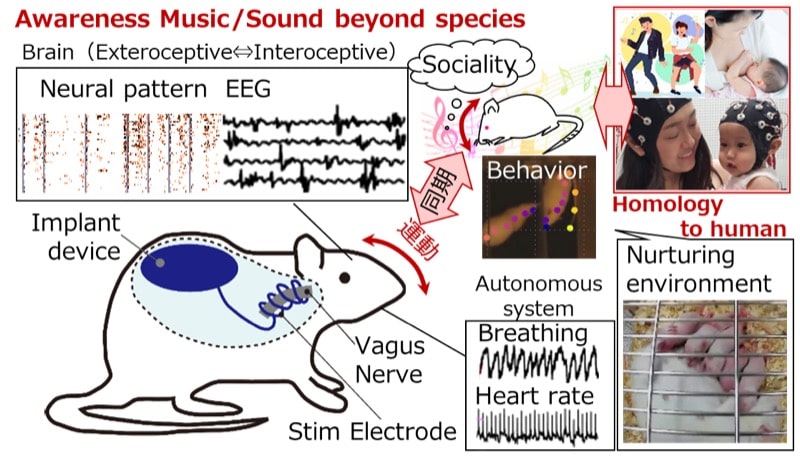Progress Report
Innovation in “Mental Capital” through Awareness Music and creation of new liberal arts5. Identification of Awareness Music/Sound and the AMS Effects of Sensitive Period
Progress until FY2022
1. Outline of the project
Music has strong appealing power to the auditory, motor, emotional, and proprioceptive systems. We investigate how music appeals to the brain to create the Awareness Music Sound (AMS). We specifically focus on how the interaction between interoceptive and exteroceptive perception has developed in the evolutionary process, and experimentally verify the homology between humans and animals. In addition, we examine how the auditory environment during infancy (i.e., the sensitive period) affects the development of the interoceptive perception and its neural basis.
In this project, we would like to (i) identify the acoustic information structures of AMS (i.e., rhythms, chords, ultra-high frequency tones, etc.) that may promote the awareness of the interoceptive perception, (ii) investigate how manipulation of autonomic nervous systems (e.g., vagus nerve system) affects the interoceptive and exteroceptive perception, (iii) investigate how a nurturing environment such as mother-child separation and/or an early exposure to music during the sensitive period influences the neural development of exteroceptive and interoceptive sensory systems, (iv) elucidate how music promotes interaction and sense of unity among individuals in terms of inter-individual synchronization of motor and interoceptive systems, and (v) implement AMS in the society across species between humans and animals (e.g., pets).
2. Outcome so far
We have physiologically and behaviorally verified the effects of AMS in animal experiments. We specifically elucidated how the rhythm in music gained appeal to the brain. A wireless accelerometer attached to the head of a rat precisely revealed that rats show beat synchronization most disinctly in the original music and that the beat synchronization pattern during music was similar between rats and humans. We then demonstrated that the neural dynamics in the auditory cortex matched the dynamics of music, suggesting that music has developed in human society over a long period of time because of a strong appeal power to the brain across species. Thus, our study demonstrated that rats can serve as a groundbreaking experimental model to verify the effects of AMS.
3. Future plans
We will (i) investigate how the interaction between interoceptive and exteroceptive awareness evolves, (ii) verify the homology of AMS effects between humans and animals, (iii) establish physiological setups to monitor and regulate the autonomic and emotional states in rodents, (iv) translationally investigate autonomous system, e.g., heartbeat evoked potential and vagus nerve stimulation, (v) investigate how AMS can appeal to the autonomic and emotional systems and promote interoceptive awareness, and (vi) translationally clarify the long-term exposure effect of AMS in behavior and physiological experiments.
(TAKAHASHI Hirokazu, University of Tokyo)
